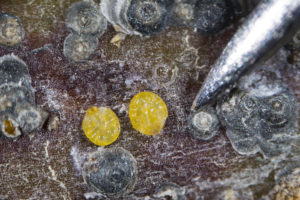Insect Management
I have seen some pretty impressive infestations of overwintering San Jose scale this spring. These infestations re-emphasize the importance of putting on a dormant oil spray each spring, as scales are one of the pests controlled by that application. SJS overwinters as an immature and is now at the point of maturing. Shortly after, they[Read More…]
I achieved biofix today (May 9) in our orchard at the Meigs Farm near Lafayette. I have also talked to other growers who had also caught 3-5 moths or more in their pheromone traps. For me, I had caught one moth last week and caught three more over the weekend. This constitutes a sustained flight and[Read More…]
Everyone knows that pollinators, including but not limited to honey bees, are important for the production of fruit crops. A big topic in recent years has been the stresses that reduce honey bee populations. Although not most important, pesticides are one factor that can reduce the populations of pollinators. Here are some things fruit growers[Read More…]
Apple growers should have their codling moth pheromone traps in place now. See the April 12 edition of Facts for Fancy Fruit for details of where traps and pheromone lures can be purchased. Traps should be checked for moths several times per week, if not daily. Pheromone lures should be replace about every 3 weeks.[Read More…]
A number of growers have experienced increasing problems with woolly apple aphids over the last several seasons. Part of the reason for the increased populations may be related to the changing spectrum of insecticides you are using to control other pests. Our experience has been that many of the aphicides that are available that provide[Read More…]
Management of European red mites is a continual process. Decisions made throughout the growing season will affect your mite populations. Outlined here are steps that can help with mite management. For a more complete explanation, please see the following publication: https://extension.entm.purdue.edu/publications/E-258.pdf. Put on a timely Superior oil spray. See the article above. Conserver predator[Read More…]
One of the first and most important parts of a good insect and mite management program is the application of an early season oil spray to control European red mites, San Jose scale, and several species of aphids. Scales overwinter on the tree as nymphs and European red mites and aphids overwinter as eggs. Because[Read More…]
One way insects communicate with individuals of the same species is with pheromones. Pheromones are volatile chemicals released by an insect that usually can be detected only by individuals of the same species. There are a number of different types of pheromones, but the most common type is the sex pheromone. Usually the females will[Read More…]
There are some potential pest and disease problems that require early season sprays. Phomopsis is a major problem on many grape varieties in the Midwest. Mancozeb should be applied starting at 1-3 inch shoots and repeated each 7-10 days, especially prior to a predicted rain event. Colleagues in Michigan and Ohio have been conducting evaluations[Read More…]
